|
|
| HOME | PROTECTION | NATURE | PLAN YOUR VISIT | FAQ | JOIN/DONATE | ABOUT |
|
|
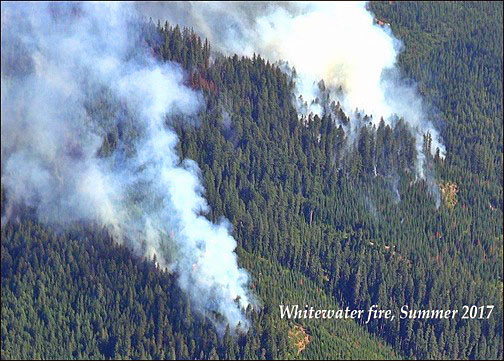 |
|
Forest Forest Wildfire Within the Proposed Douglas-Fir National Monument The area of the proposed Douglas-Fir National Monument
encompasses the heart of the the coastal Douglas-fir forests that
range from British Columbia to California. As such, it is subject
to the same risks of wildfires, and to the same controversy about
wildfires, that confront other parts of the Pacific Northwest. Fires are Historically not Uncommon and are Vital for Old-Growth and Other Forests Historic studies show that larger wildfires are common periodically in the Pacific Northwest. Millspaugh, et. al., Geology 2000, Steel, et. al., Ecosphere 2015. Episodic fires are not only usual, but contribute to the establishment, continuation and renewal of old-growth forests. The old-growth forests we love and admire today were born after large natural, stand-replacing disturbances: usually fire, but also sometimes from a major windstorm, massive outbreak of a natural native insect or disease pathogen, or even the occasional volcano. Science Refutes Common Myths About Wildfires Scientific studies have recently shown that: |
|
A New Approach to Wildfires in the Proposed Douglas-Fir National Monuments |
| One of the benefits of the creation of the Douglas-Fir National Monument can be a demonstration of the value of a new approach to dealing with wildfires. A properly managed Douglas-Fir National Monument can: |
| • Demonstrate the value of treating different fires differently. More than 80 percent of western fires are human caused, rather than by lightning. Most human caused fires start within a mile of a road. Human-caused fires should continue to be discouraged through education, enforcement, punishment and limiting access during extreme weather conditions that make human-caused ignitions more likely. Natural, lightning-caused fires should be allowed to burn as natural fires. The result will be that in some, or many, cases the fires go out on their own, especially if weather conditions, fuel conditions, and locations favor such outcomes. In other cases, the fires will burn over thousands of acres and perhaps for several weeks until the weather changes and the fires are naturally extinguished. This is what happened throughout history, and what happens now for most large fires, despite the millions spent to fight the fires. |
• Demonstrate fire’s natural place in the forest. Within the proposed Douglas-Fir National Monument, natural fire is infrequent; on average, fire affects a particular stand of trees only once in several hundred years. What makes old-growth Douglas-fir forests so magnificent is that large accumulation of living wood. It rarely burns because the old-growth trees have very thick and fire-resistant bark. You’ll often see char marks on some very old and very living trees. |
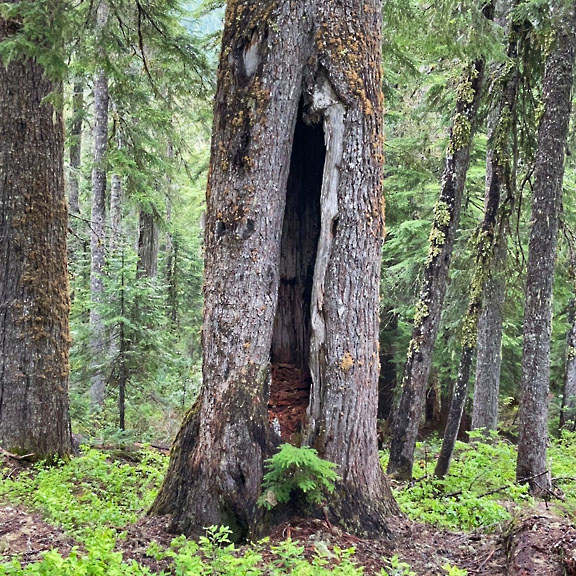 |
| • Demonstrate that natural fires do not create a total wasteland. A visit to a burned-over area after a wildfire, especially to older forest areas, will show to the understanding observer that: |
-- Many parts of a “wildfire area” are not devastated by the passing fire, while other areas are only lightly affected. See the official Forest Service map of the area “burned” by the Lionshead fire. The blue and green areas indicate that, in much of the burn, less than half the trees were killed by the fire. This mosaic of burned and unburned is common to all wildfires. |
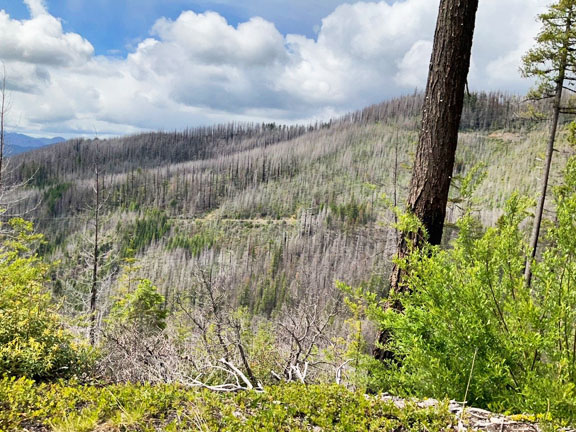 |
 |
-- The burned areas immediately start regenerating. Left alone (no salvage logging), the forest turns green the next spring and every year thereafter. Wildflowers abound in the new "preforest" or "early seral forest." If not disturbed after a fire, the preforest will move first into a young forest, then a mature forest, and finally to an old-growth forest again that will likely exist for several hundred years, or longer. |
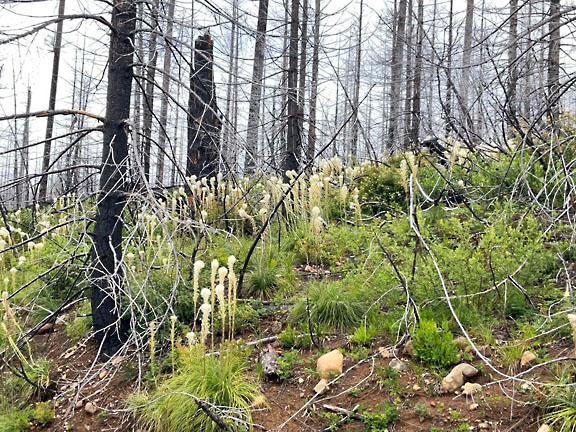 |
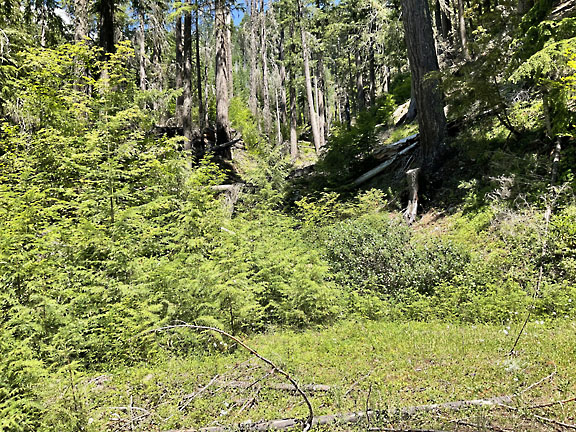 |
-- Fires benefit many native species of fish, wildlife, and plants. Some species, such as the black-backed woodpecker shown on this page, thrive in recently burned forests. The grasses, flowers and shrubs that begin growing immediately in a burned area provide important habitat for many insects, birds and mammals. Go to this link for the full story: Wildlife That Depend On Wildfire To Survive - YouTube |
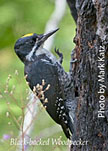 |
-- Most of the above-ground carbon stored in a forest remains after a fire. Despite the seeming massive release of carbon by a fire, the vast majority of the forest carbon remains in the form of residual standing live or standing dead (snags) or downed trees. This carbon will eventually be stored in the ground, unless it is subject to “salvage logging.” Salvage logging, like any logging, emits much more carbon than it preserves. In a recent letter to Congress, climate and forest scientists warned that logging in U.S. forests emits more than 10 times the carbon emitted by wildfires and insects combined. |
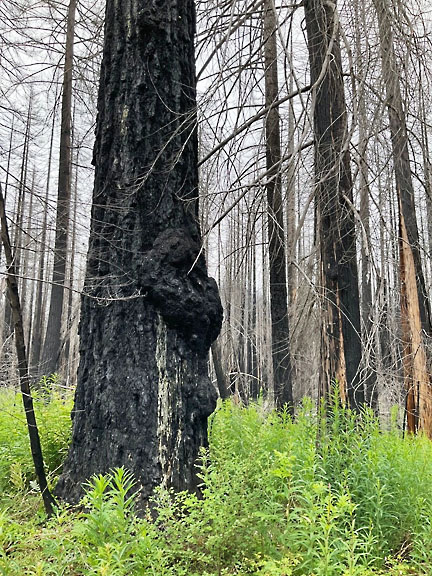  |
| • Show in a large landscape area the diversity of a true, natural Douglas-fir forest. In an older (mature and old growth) forest, fire (also wind, insects, pathogens and the occasional volcano) do disturb a part of the old-growth forest. If left to nature, the portion where there is stand-replacing loss becomes complex, early seral forest, that is, the first stage in the succession of a forest. In this case, grasses, wildflowers and young shrubs begin to grow. An early seral forest can last decades from the disturbance until conifers again dominate the site (young forest). An early seral forest is extremely biologically diverse. As this habitat is made up of many plant species, it is attractive to a host of wildlife species, from birds to mammals to amphibians to mollusks. • Demonstrate that old-growth forests do better in a natural wildfire regime than do more intensively managed forests, especially monocultural "plantations." Scientific comparisons of fires across the west have concluded that this is true, but the Forest Service still justifies logging and forest management because of the “threat” that these areas pose to nearby heavily managed areas. A visit to the recent wildfire area leads to the conclusion that the fires burned more fiercely and killed more trees in previously logged areas, especially areas replanted as single-species plantations, than was true in old-growth areas. |
|
Fight Wildfires with Defensible Space Wildfires outside the national forest may create a danger to homes and communities built into the what has come to be called the wildland-urban interface (WUI). Unfortunately recent history of wildfires shows that, despite billions spent on fighting large-scale wildfires, wildfires that reach into the WUI do adversely affect many buildings. This suggests that once started, spending thousands, or millions, to fight a wildfire will not protect buildings within the WUI. Just as science has caused a re-examination of the place of wildfires in forest ecology, studies of the WUI have shown that creating Defensible Space including and directly adjacent to the structure is the best way to protect homes and buildings in the WUI. |
Go back to the HOME
page